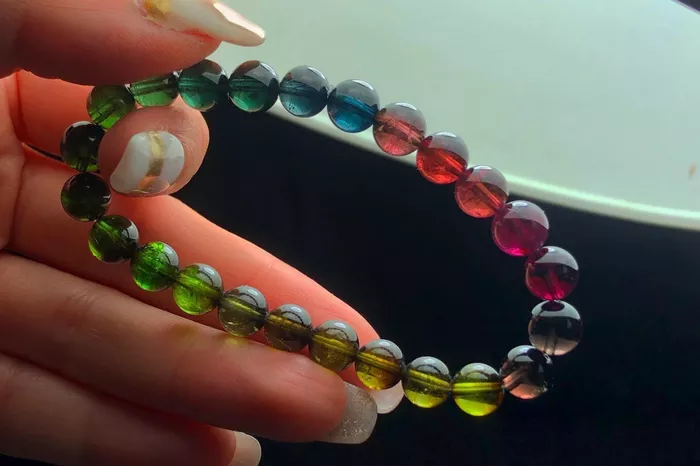Grape tourmaline, a gemstone of captivating beauty and intriguing characteristics, stands out in the world of gemology. This article aims to provide a comprehensive and detailed introduction to grape tourmaline, covering its unique properties, geological origins, color variations, popularity, and uses. Through a logical and easy-to-understand approach, readers will gain insights into this fascinating gemstone.
Geological Origins
Grape tourmaline belongs to the tourmaline family, which is one of the most complex and diverse gemstone groups. Tourmaline is a silicate mineral with a unique crystal structure that often exhibits a wide range of colors. The name “tourmaline” is derived from the Sinhalese word “turmali,” meaning “mixed stones” or “stone with various colors,” reflecting its color diversity.
Geologically, grape tourmaline forms under specific conditions within igneous, metamorphic, and sedimentary rocks. It is often found in pegmatites, which are large, coarse-grained igneous rocks. These rocks can contain high concentrations of minerals, including tourmaline. The formation of grape tourmaline involves complex geological processes, including the crystallization of minerals from molten magma or the metamorphosis of rocks under high pressure and temperature.
Unique Properties
Grape tourmaline is characterized by its distinct appearance and physical properties. The term “grape” refers to the gemstone’s unique growth pattern, where individual crystals form clusters resembling grapes. These clusters can range from small, individual “berries” to larger, more complex clusters. The color of grape tourmaline can vary widely, with shades ranging from deep purple and red to green and even colorless varieties. The most sought-after and valuable colors are typically those with vibrant hues of purple, pink, or red.
In addition to its color, grape tourmaline is known for its pyroelectric properties. This means that it can generate electricity when heated, and its crystals can become polarized, attracting small particles like dust or paper shavings. This property is unique among gemstones and adds to the fascination surrounding grape tourmaline.
Color Variations
The color of grape tourmaline is influenced by several factors, including its chemical composition and the presence of trace elements. The most common colors are shades of purple, pink, and red, but green, blue, and even colorless varieties can also be found. The color intensity and saturation can vary widely, leading to a spectrum of appearances.
Purple and pink grape tourmalines are often the most popular and valuable. These colors are caused by the presence of manganese and other trace elements within the mineral’s crystal structure. Red grape tourmalines, sometimes referred to as “rubellite,” are particularly rare and highly valued. Green grape tourmalines, on the other hand, can be caused by the presence of iron and can exhibit a range of shades from light to dark green.
Popularity and Uses
Grape tourmaline has gained popularity in recent years due to its unique appearance and relative scarcity. Jewelry designers have embraced this gemstone, incorporating it into a variety of pieces, including rings, necklaces, earrings, and bracelets. Its vibrant colors and interesting growth patterns make it an excellent choice for creating unique and eye-catching designs.
Beyond jewelry, grape tourmaline is also used in other applications. It can be found in collector’s items, including gemstone spheres, carvings, and specimens. Its unique properties and beauty make it a desirable addition to any gemstone collection.
Jewelry Creation
The process of creating jewelry from grape tourmaline involves several steps. First, the gemstone must be carefully mined and extracted from its host rock. This can be a challenging process, as grape tourmaline is often found in complex geological environments. Once extracted, the gemstone is cleaned and polished to reveal its natural beauty.
During the jewelry-making process, grape tourmaline can be set in a variety of metals, including gold, silver, and platinum. The setting style can range from simple and elegant to more intricate and detailed. Designers often use grape tourmaline in combination with other gemstones, such as diamonds, sapphires, and emeralds, to create stunning and unique pieces.
Investment and Value
Grape tourmaline is considered a valuable gemstone, and its price can vary depending on several factors. The most significant factors include color, clarity, cut, and carat weight. As with other gemstones, the deeper and more vivid the color, the higher the value. Clarity is also important, as gemstones with fewer inclusions are typically more valuable.
Cut and carat weight also play a role in determining the price of grape tourmaline. Well-cut gemstones that maximize their brilliance and fire are more valuable than those with poor cutting. Carat weight, of course, refers to the size of the gemstone, and larger pieces are typically more rare and valuable.
Due to its unique properties and scarcity, grape tourmaline is considered a good investment. Its value has been increasing steadily over the years, and it is expected to continue to appreciate in the future. Collectors and investors alike appreciate the beauty and potential for growth of this gemstone.
Caring for Grape Tourmaline
Like all gemstones, grape tourmaline requires proper care to maintain its beauty and value. It is important to clean the gemstone regularly using a soft cloth and warm water. Avoid using harsh chemicals or abrasive materials, as these can scratch or damage the surface.
When storing grape tourmaline, it is best to keep it in a fabric-lined box or jewelry pouch to prevent scratching and to protect it from exposure to direct sunlight or extreme temperatures. It is also advisable to remove grape tourmaline jewelry before engaging in activities that could subject it to physical trauma, such as sports or heavy labor.
Conclusion
Grape tourmaline is a gemstone of unique charm and beauty. Its distinct growth pattern, vibrant colors, and pyroelectric properties make it a fascinating and desirable gemstone. From its geological origins to its uses in jewelry and investment, grape tourmaline offers a rich and diverse story. By understanding its properties and how to care for it, gemstone enthusiasts can appreciate and enjoy this radiant gemstone for generations to come.
Related topic:
- How to Tell if Pink Tourmaline Is Real
- What Does a Tourmaline Crystal Do
- Is It Worth It to Buy Tourmaline?


